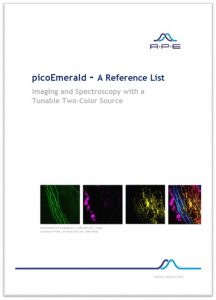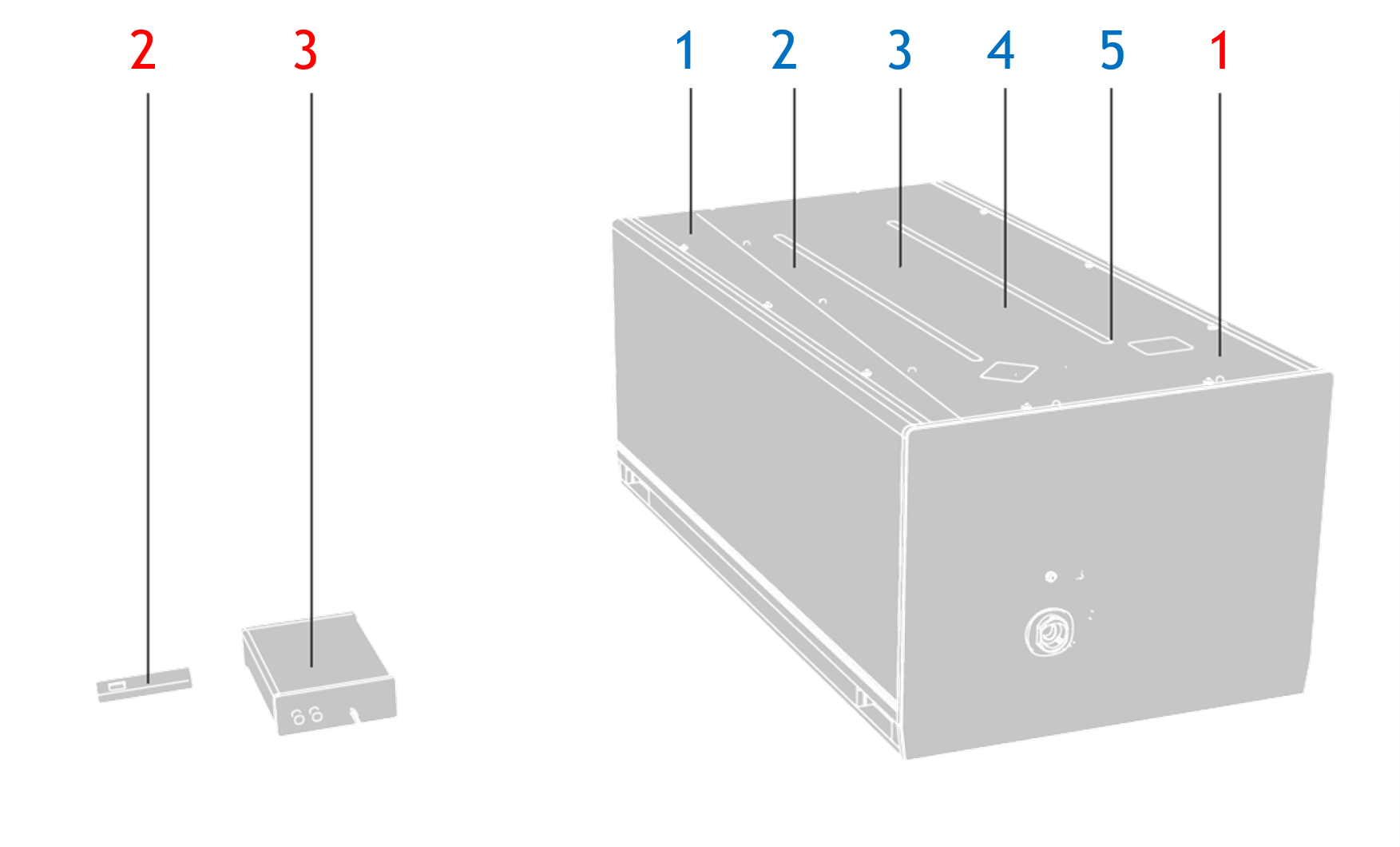| 제조사 | APE |
|---|---|
| 가격 | TBD |
| 문의 | 02-3461-1103 |
SRS Microscopy and CARS Spectroscopy with a Tunable ps Two-Color Laser
APE picoEmerald CARS SRS rev.3.1 (pdf / english)
APE Reference Guide picoEmerald Okt 2017 Rev.3.2.1 (pdf / english)
APE SRS Detection Set Rev 3.1.2 (incl. Lock-in Amplifier & Detector; pdf / english)
Application Note
Application Note 2ps non-linear microscopy with picoEmerald (pdf / english)
Poster
APE Multimodal and Nonlinear Microscopy Part 2 (pdf / english)
CARS & SRS in a Single-box
SRS Stimulated Raman Scattering microscopy and CARS Coherent Anti-Stokes Raman Spectroscopy have migrated from physics labs to life-science labs, so APE has responded with an easy-to-use and truly hands-off SRS and CARS light source: picoEmerald. In a single-box, picoEmerald provides fully automated temporal- and spatial-overlapping ultra-short pulse trains: 1032 nm from the laser oscillator, plus the OPO Signal beam, and OPO Idler beam.
Turning Complexity into a Turn-Key System
The light source is the most crucial and complex component of a SRS or CARS microscopy system. Proper setup and calibration are essential for accurate and reproducible imaging. picoEmerald is a turn-key system combining user-friendly automation features and the utility of open-architecture light sources in a single box.
Applications
- Stimulated Raman Spectroscopy (SRS)
- Coherent Anti-Stokes Raman Spectroscopy (CARS)
- SRS Microscopy of Vibrational Probes
- Second Harmonics Imaging (SHG)
- Pump-Probe Spectroscopy
- Surface Enhanced Hyper Raman Spectroscopy (SEHRS)
Setup and Use with Microscopes
picoEmerald is compatible with nearly all popular confocal microscope systems. The current publication list names at least those configurations:
- Home-built setups
- Leica SP-Series
- Olympus FV-Series
- Nikon Ti-U Platform
- Thorlabs Multiphoton
- Zeiss LSM-Series
- Horiba
By integrating SRS and CARS technology into Leica’s confocal SP5/SP8 microscopy system, Leica Microsystems has tightly integrated the picoEmerald into their LAS AF system software. Similary tight software integration is also available with Thorlabs’ multi-photon microscopes. Software integration into other third-party microscopes or home-built setups is also supported. Ethernet TCP/IP and serial RS232 interfaces are available with picoEmerald for this purpose. APE’s user-friendly automation combined with a graphical user interface (GUI) also makes it convenient when using picoEmerald and microscope as independent instruments, without the need for software integration.
Introduction to Stimulated Raman
Stimulated Raman Scattering (SRS) is based on the effect that excited molecules emit spontaneous Raman scattering, SRS is a further development of CARS. In the event of two different laser beams with a frequency difference which matches the vibrational frequency, the Raman signal will be amplified. So this process is not spontaneously anymore, it is stimulated.
This technique requires two laser beams. A Pump and a Stokes beam. One of these beams must be tuneable in order to meet the difference of the frequencies, so that the molecules can be excited into the virtual state and to bring it to the vibrational state. As at CARS, the molecules are only excited if the frequency coincides with the vibrational resonance.
The tuneable Pump beam gets a loss in intensity after excitation of the molecules (stimulated Raman loss, SRL). On the opposite, the intensity of the non-tuneable Stokes beam increases (stimulated Raman gain – SRG).
The different intensities between input Pump beam and output Pump beam are very low. So low, that the true measurement signal is lost in the noise. To measure this difference, the lock-in technique is used. For this the Stokes beam is modulated to a fixed frequency by an Electro-Optical Modulator (EOM). APE has integrated such EOM into picoEmerald. Together with APE’s Lock-In Amplifier / SRS detection module – dedicated detector / amplifier combination – the low differences can now be visualized.
Unlike CARS, SRS provides results with no non-resonant background. The assignments of CARS spectra are more complicated and thus the interpretation is more susceptible to errors. SRS is based on spontaneously Raman scattering and so the obtained SRS spectra are almost identical with spectra of spontaneously Raman scattering. Furthermore, SRS signal is directly linearly dependent to the concentration.
Reference Guide
In our reference guide we present more than 50 + publications for which the picoEmerald has been used to employ Stimulated Raman Scattering or Coherent anti-Stokes Raman Spectroscopy. Here it is available for Download: APEs picoEmerald Reference List Edition October 2017
Turning Complexity into a Turn-Key System
The light source is the most crucial and complex component of a CARS Coherent Anti-Stokes Raman Spectroscopy or SRS Stimulated Raman Scattering system. Proper setup and calibration are essential for accurate and reproducible imaging. picoEmerald is a turn-key system combining user-friendly automation features and the utility of open-architecture light sources in a single box.
CARS
Excitation of CARS and SRS microscopy requires two laser wavelengths, one of which must be tunable. The (1) 1032 nm beam (2 ps Stokes beam) is generated at 80 MHz repetition rate. The pump beam is provided by the incorporated (2) OPO and is tunable from 700 to 990 nm and 1080 … 1950 nm. The spatial and temporal overlapping of the Stokes and pump beams are achieved via dichroic mirrors and a (3) delay stage inside the picoEmerald. The (4) sensors and the integrated beam management for the temporal and spatial overlap, and a (5) high resolution spectrometer secure the proper system calibration.
SRS - Stimulated Raman Scattering
The SRS setup is complemented by a built-in (1) EOM (to modulate the intensity of the Stokes beam), and the (2) SRS detection module. The detection module incorporates a large-area (10 x 10 mm) (2)photodetector – optimized for the VIS / NIR range – and is illuminated by the pump beam. The detected photocurrent enters the highly sensitive (3) lock-in amplifier. In this way, the intensity of the modulation transfer from Stokes to pump is measured. The integration time of the lock-in amplifier can be set to different integration times between 100 ns and 20 μs. Increasing the integration time leads to an improved signal-to-noise ratio. Finally, the extracted Stimulated Raman Scattering signal is provided and can be sent to the microscope’s data acquisition unit.
SRS Detection Set: Unique Lock-In Amplifier & Detector Combination
The SRS Detection Set consisting of a unique sensor and lock-in amplifier combination has been developed specifically for demanding SRS imaging applications. Very short integration times down to 100 ns are ideally suited for fast and accurate video rate imaging. Its works perfectly together with APE’s picoEmerald SRS light source as well as home-built and third-party SRS setups.
Specifications
| picoEmerald Specification | |
|---|---|
| Main Parameters | |
| Type of Source | Automated picosecond (narrow-band) tunable light source |
| Wavelength 1 1032 nm Beam | 1032 +- 1.5 nm |
| Wavelength 2 OPO Signal | 700 ... 990 nm |
| Wavelength 3 OPO Idler | 1080 ... 1950 nm |
| Power 1 1032 nm Beam | > 700 mW (customized versions on request) |
| Power 2 OPO Signal | > 700 mW at 800 nm |
| Power 3 OPO Idler | > 400 mW at 1250 nm |
| dn OPO Signal - OPO Idler | 800 ... 9000 cm-1 |
| dn OPO Signal - Fundamental | 400 ... 4500 cm-1 |
| Pulse Width | 2 ps (others on request) |
| Repetition Rate | 80 MHz |
| Spectral Bandwidth Signal, 1032 nm beam | 10 cm-1 |
| Beam | |
| Beam Diagnostics | Integrated for Signal Wavelength, Power, Bandwidth, Beam position, Temporal overlap |
| Pointing Stability | < 100 µrad per 100 nm |
| M2 | < 1.2 (OPO Idler and Signal), typ. 1.2 (1032 nm beam) |
| Ellipticity | < 10 % |
| Polarization | Linear; Horizontal > 100:1 |
| Beam Divergence | 1.0 (+- 0.2) mrad (at 800 and 1032 nm) |
| Beam Waist Diameter | 1.2 (+- 0.2) mm at 800 nm; 1.7 (+- 0.2) mm at 1032 nm |
| Software | |
| Software and Automation | Included |
| Wavelength Sweep Function | Start/End Function, User-defined Holding Time, Trigger Function, max. 2 nm step size, |
| approx. 5 s per wavelength step | |
| Remote Control | Possible via USB / Ethernet TCP/IP / Serial RS232 |
| SRS | |
| SRS Detection Set (Optional) | Unique Lock-In Amplifier & Detector Combination Sensor: 10 mm x 10 mm active area; 340 ... 1100 nm spectral response Lock-In Amplifier: 8 MHz ... 20 MHz; Time constants: 100 ns, 300 ns, 2 μs, 10 μs, 20 μs; Typ. Sensitivity: Δ I/I = 5 x 10-7 for 20 μs integration time (at 50 mW / 800 nm) Datasheet is available from the download tab. |
| SRS Modulator EOM (Optional) | EOM with a resonant fixed frequency of 10 MHz (or 20 MHz) modulation frequency; Built into picoEmerald |
Stimulated Raman Scattering (SRS)
Stimulated Raman Scattering (SRS) microscopy for non-invasive label-free imaging is facilitated via the picoEmerald system. SRS microscopy provides almost background-free imaging contrast. It allows simple spectroscopic identification of the samples’ fingerprint region based on Raman spectra databases. Imaging with video-rates is possible due to very short integration times of the SRS detection module (Lock-in Amplifier). Switching over to SRS microscopy is relatively straightforward for researchers who already have CARS experience.
Coherent Anti-Stokes Raman Spectroscopy (CARS)
CARS Coherent anti-Stokes Raman Spectroscopy (as well as Stimulated Raman Scattering) create high imaging contrast without labeling. The technology involves two laser beams. CARS is sensitive to the vibrational modes of samples and visualizes the vibrational contrast of molecules. The samples, even living objects, remain almost unaffected.


